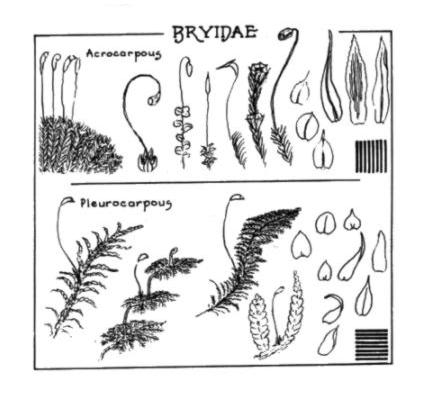 |
|
 |
|
A Graphic Guide to Ontario Mosses
by Robert Muma |
| |
|
|
Classification
of Mosses
|
| |
|
The
class MUSCI (Mosses) is divided
into three sub-classes: (See illustrations)
1. SPHAGNIDAE
a small sub-class consisting of a single family and a single genus with 135
species worldwide. These are the
familiar SPHAGNUM mosses of the peat bogs.
2. ANDREAEIDAE
has
two families; only two species in genus ANDREAEA are in our area. These are boreal and alpine rock mosses.
|
|

|
| |
|
3. BRYIDAE contains
all other mosses, of numerous genera and an estimated 10,000 species throughout
the world. They belong to many
families, but it is more useful to divide the genera into two growth forms.
These are known as (a) Acrocarpous mosses and (b) Pleurocarpous mosses. In any standard systematic guide to the mosses you will find (with only
two or three exceptions) the first group in the first half of the book, and the
second group in the latter half. Recognition
of these two growth forms constitutes the basis for this guide. (For
moss-anatomy terms mentioned below, see Anatomy of a
Typical Moss Plant.)
|
| |
|

|
 |
(a) Acrocarpous mosses are those which grow upright as
individual plants, either separately or very close
together to form a turf, tuft, or cushion. In
this group, the leaves nearly always have a costa, and the sporophyte grows from
the tip or highest part (acros: highest;
karpos: fruit). Some of the common acrocarpous genera are
DICRANUM, TORTELLA, BARBULA, MNIUM, BRYUM, POLYTRICHUM. Perichaetial leaves not usually visible.
Denoted by the vertical lines symbol. |
|
| |
 |
(b) Pleurocarpous
mosses are the prostrate
or creeping plants on ground, wood, or rock surfaces. Some of these add new intertwining or overlaid growth each year to form
mats. The leaves are usually
without costa and the sporophyte grows from the side of one of the branches of
the plant (pleura: side; karpos: fruit). The perichaetial leaves are longer and often quite different from the
regular leaves. Many of the
pleurocarpous mosses are known popularly as "feather mosses" and
"fern mosses", including the genera HYPNUM, THUIDIUM, AMBLYSTEGIUM,
BRACHYTHECIUM, PLAGIOTHECIUM, HYLOCOMIUM.
Denoted by the horizontal lines
symbol. |
|
| |
|
| |
|
Identification
|
| |
-
Note the
symbols for acrocarpous and pleurocarpous
and pleurocarpous moss forms and look for the clues to
your specimen's genus under the applicable symbol in the Growth-Form
plates.
moss forms and look for the clues to
your specimen's genus under the applicable symbol in the Growth-Form
plates.
-
If your
specimen has sporophytes* check their posture on the Sporophyte
Characteristics page.
-
Also
check for Habitat.
|
|
Note:
In this Guide the name of each genus is shown in
upper case letters, e.g. BRYUM. Where a single species is relevant, the genus
(in capitals) is followed by the specific name in lower case, as BRYUM argenteum.
Where broader classifications are mentioned, they are shown in upper case
italics, i.e. family, order, sub-class, and the phylum (BRYOPHYTA).
* Some mosses seldom produce sporophytes but tend to reproduce asexually.
|
| |
|
Previous
Next
|
|
|
|

